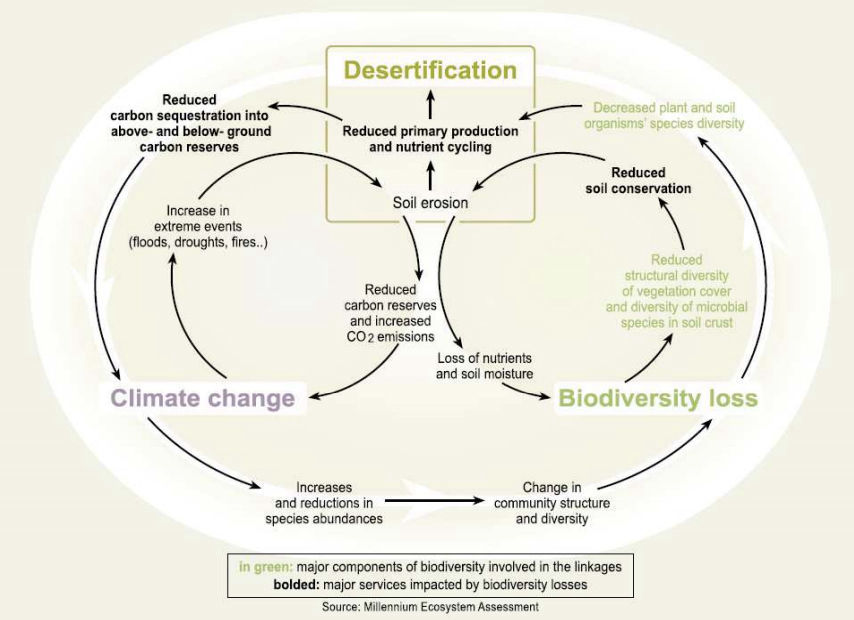
Desertification is known by scientists as a severe problem of land degradation that occurs in all kinds of landscapes over the world. Fertile lands are turned into drylands where biological productivity is dramatically annulled or strongly limited due to natural processes and often caused by wrong human activities.
In some extreme cases this phenomenon is not reversible, due to prohibitive costs for recovery the land. Prevention is all that we have in our hands to avoid this risk.
Desertification has been classified as the greatest environmental challenge of our time and climate change with its global warming of our planet is exacerbating the problem. The consequences of these environmental phenomena are devastating, with enormous social and economic costs.
UNCCD (United Nation Convention to Combat Desertification) has scientifically defined the desertification as “diminution or destruction of the biological potential of the land which can lead ultimately to desert-like conditions.”
Worldwide recognition of desertification as a transnational environmental problem did not come about until 1968, when a severe drought struck the Sahel, a region in western Africa lying along the southern margin of the Sahara.
In other words desertification can be explained as the result of extended periods of drought in arid, semi-arid, or dry sub-humid areas — also referred to as drylands — in which the land’s productivity is strongly limited and the fertile soil it becomes “dead” soil.
There are more than one human activities that contribute to desertification process including the expansion and intensive use of agricultural lands, wrong or poor methods for irrigation, deforestation practice, and unsustainable overgrazing like too many animals placed on the same land placing enormous pressure on the land, altering in strong way its soil chemistry and hydrology of the territory.
The final effects are erosions, soil salinization, loss of productivity and moreover decreased resilience to climatic variations until reaching a point of no return for life.
Global warming due to the atmospheric build-up of carbon dioxide and other gases emitted by fossil fuel combustion threatens is complicating this situation day by day, month after month, year by year.

Climate change and desertification are two sides of the same coin and must be tackled together.
Every rising in global temperatures has like result the accelerating of the process of desertification. The greater the heat on earth and the greater the melting of the ice and the evaporation of water in all its forms that we know (aquifers, rivers, lakes, seas).
Desertification occurs worldwide touching all continents except Antarctica and affects the livelihoods of millions of people, including a large proportion of the poor in drylands. Multiple and different negative effects can be seen locally, nationally, regionally, and globally.
While people have managed fragile drylands successfully for millennia in many parts of the world, pressure upon the land is much greater today as roughly 2 billion people inhabit drylands around the world.
Therefore we must always keep in mind that drylands occupy 41% of Earth’s land area and are home to more than 2 billion people — a third of the human population in the year 2000.
Worldwide, the International Committee of the Red Cross has also estimated that 25 million of the world’s refugees — 58 percent — are fleeing degraded lands where water scarcity limits the production of crops, forage, wood, and other essential raw materials for people's livelihood and for the economy.
If we consider that 70.8% of the whole planet is covered by water and in the remaining 29,2% of emerged surface around 40% is represented by drylands, we should understand how is very important for humans the preservation of the fertile lands and really necessary invest into defending our planet from the desertification.
For these reasons knowing and possibly studying this problem and its devastating effects on people's lives would allow us to better understand what is happening on the planet on which we live, understand and accept our responsibilities, and immediately implement measures to react to emergency. A moral duty for everyone.
desARTification project has been developed as an artistic contribution for spreading awareness around the world on the topic of desertification and climate change.
We invite you to also visit the following websites by third parties where you'll find further updated news and more scientific information about these issues.
Suggested links on desertification and climate change facts:
| UNCCD - official site: www.unccd.it
| USGS - official site: www.usgs.gov
| Carbon Brief - official site: www.carbonbrief.org
| National Geographic - official website: www.nationalgeographic.com
| Britannica - official website: www.britannica.com
| Wikipedia - official website: www.wikipedia.org
Etymology: “English desert and its Romance cognates (including Italian and Portuguese deserto, French désert and Spanish desierto) all come from the ecclesiastical Latin dēsertum (originally "an abandoned place"), a participle of dēserere, "to abandon”.
The term desertification was first used in West Africa in 1949 by a French forester to describe the way in which it was perceived that the Sahara Desert was expanding to encompass desert-marginal savannah grasslands. Afterwards it was realised that desertification was not only happening in Africa but in dryland areas worldwide (UNEP, 1997).